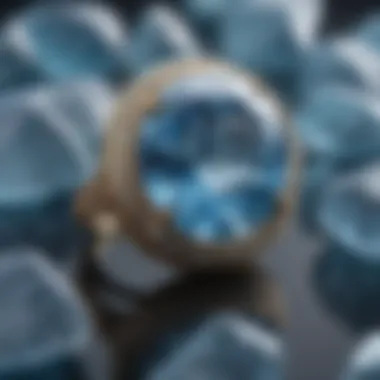Unveiling the Enchanting World of Light Blue Gemstones: A Journey of Beauty and Mystery


Rock and Fossil Identification
When delving into the world of light blue gemstones, one must first understand the importance of rock and fossil identification. Precise identification is crucial as it determines the rarity and value of these mesmerizing gems. In this section, we will explore the various types of rocks and fossils that host light blue gemstones. Understanding the characteristics to look for in these rocks and fossils is essential for any collector or enthusiast. Utilizing specialized tools for identification enhances the process, allowing for a more accurate and detailed examination.
Geological Insights
Moving beyond identification, delving into geological insights opens a gateway to a deeper understanding of light blue gemstones. Exploring the geological formations and processes that contribute to the creation of these gems provides invaluable knowledge. Unveiling the historical significance of these rocks and fossils adds another dimension to their allure. Furthermore, learning about notable discoveries in the field sheds light on the continuous evolution of gemology. This section will serve as a comprehensive guide to the geological intricacies of light blue gemstones.
Introduction to Light Blue Gemstones
Defining Light Blue Gemstones
Understanding the color spectrum in gemology
The realm of gemology is vast and intricate, with the color spectrum playing a pivotal role in defining the allure and value of gemstones. Understanding the nuances of the color spectrum is crucial in discerning the subtle variations in light blue gemstones. From the soothing tones of aquamarine to the delicate hues of kyanite, each gemstone reflects a unique essence derived from its position within the color spectrum. By delving into the complexities of color grading and interpretation, we uncover the mysteries that make light blue gemstones an intriguing choice for enthusiasts and collectors.
Distinguishing light blue from other shades
Distinguishing light blue from its counterparts is a delicate art that requires keen observation and a discerning eye. The subtle shifts in hue and saturation set light blue gemstones apart from their counterparts, a distinction that adds to their charm and allure. By exploring the key characteristics that differentiate light blue from other shades, we gain a deeper appreciation for the diversity within the realm of gemology. From the serene tranquility of celestite to the vibrant allure of blue topaz, each gemstone holds a unique position within the spectrum of blue, waiting to be illuminated and admired.
Significance of Light Blue
Cultural and historical symbolism
Embark on a journey through time as we unravel the cultural and historical significance of light blue gemstones. From ancient civilizations to modern-day interpretations, these gems have woven a rich tapestry of symbolism and meaning. Whether adorning royalty or gracing spiritual practices, light blue gemstones have held a prominent place in human history. Exploring the depths of this symbolism unveils a world of traditions, beliefs, and customs that continue to shape our perception of these ethereal treasures.
Modern-day associations


Step into the contemporary realm where light blue gemstones continue to captivate hearts and minds with their timeless elegance. In the fast-paced world of fashion and luxury, these gems find new relevance, becoming statements of style and sophistication. Delve into the modern-day associations of light blue gemstones, from their role in pop culture to their significance in artisanal craftsmanship. As we navigate through the evolution of these gems, we discover how they seamlessly blend tradition with innovation, offering a bridge between the past and the future.
Popular Light Blue Gemstones
In the realm of gemology, the discussion of light blue gemstones holds a prominent place for its unique allure and attributes. These exquisite gemstones are not only visually appealing but also hold significant cultural and historical importance. Their popularity stems from a combination of distinct physical properties, mesmerizing color variations, and symbolic meanings that have captivated jewelry enthusiasts and collectors alike.
Aquamarine
Origins and mining locations
Aquamarine, a gemstone known for its serene blue hues, has a fascinating history intertwined with its mining locations. The origins of aquamarine can be traced to various parts of the world, including Brazil, Madagascar, and Nigeria. These mining locations play a crucial role in determining the quality and availability of aquamarine in the market. The unique geological formations in these regions contribute to the gemstone's color vibrancy and clarity, making them highly sought after by gemologists and jewelry designers. Despite the challenges posed by remote mining locations, aquamarine continues to be a popular choice for its calming beauty and natural elegance.
Physical properties and characteristics
Aquamarine boasts remarkable physical properties that set it apart from other gemstones. With a hardness of 7.5 to 8 on the Mohs scale, aquamarine exhibits excellent durability, making it ideal for various jewelry applications. Its characteristic light blue color, reminiscent of the tranquil ocean waters, evokes a sense of peace and harmony. The gemstone's exceptional clarity and transparency further enhance its visual appeal, capturing the imagination of gem enthusiasts worldwide.
Uses in jewelry and historical significance
The usage of aquamarine in jewelry dates back to ancient times, where it was believed to embody the spirit of the sea. Its historical significance is deeply rooted in myths and legends, associating aquamarine with qualities such as protection, intuition, and courage. In modern jewelry designs, aquamarine is a popular choice for its versatility, complementing both casual and formal attire. From intricate earrings to statement necklaces, aquamarine adds a touch of understated elegance to any ensemble, symbolizing purity and inner strength.
Lesser-Known Light Blue Gemstones
In this segment of our exploration into light blue gemstones, we delve into the realm of lesser-known gems, shedding light on their unique characteristics and significance within the world of jewelry and gemology. While popular choices like aquamarine shine bright, these lesser-known gemstones offer a hidden elegance waiting to be discovered.
Larimar
Discovery and Unique Features
Let us begin our journey with Larimar, a gem renowned for its fascinating discovery story and exceptional features. The discovery of Larimar is intertwined with the lore of the sea, as this gem found its way from the depths of the Caribbean waters to the hearts of gem enthusiasts worldwide. Its mesmerizing blend of sky-blue hues and intricate patterns make it a sought-after choice for jewelry connoisseurs.


Healing Properties and Metaphysical Beliefs
Turning to the metaphysical realm, Larimar is believed to possess healing properties that promote tranquility and communication. It is said to soothe emotions and enhance one's spiritual connection, making it a favored gem in the realm of holistic practices. The unique energy exuded by Larimar sets it apart as a gemstone that resonates not just with aesthetic beauty but also with inner harmony.
Artistic and Sculptural Applications
Lastly, Larimar's artistic and sculptural appeal add another dimension to its allure. Its delicate beauty and varying textures make it a versatile gem for artisanal creations. Jewelry designers and sculptors alike are drawn to Larimar for its ability to transform into intricate pieces of wearable art. The blend of elegance and creativity that Larimar offers elevates it to a gem of distinct artistic merit.
Identifying and Evaluating Light Blue Gemstones
In understanding the multifaceted world of light blue gemstones, one cannot overlook the pivotal role of Identification and Evaluation. This section serves as a lighthouse guiding enthusiasts through the intricate process of discerning subtle variations in these captivating gems. From assessing the precise shade of blue to unraveling the gem's unique characteristics, this segment sheds light on the essential techniques that form the backbone of gemological exploration.
Gemstone Identification Techniques
Visual inspection and color assessment
When delving into the realm of light blue gems, visual inspection and color assessment emerge as paramount techniques. By scrutinizing the hue saturation and clarity levels, gem enthusiasts can unravel the story each gemstone holds within. This method provides a holistic view of the gem's color spectrum, aiding in categorizing them accurately. Despite the simplicity of visual inspection, its importance in identifying and differentiating light blue gemstones cannot be overstated.
Refractive index and specific gravity
Another critical facet of gemstone evaluation is refractive index and specific gravity analysis. These measurements offer insights into the gem's optical qualities and density, contributing significantly to its overall classification. By understanding how light interacts within the gem, gemologists can unveil hidden features that set light blue gemstones apart. While utilizing refractive index and specific gravity necessitates specialized tools, their invaluable role in gemstone identification is a cornerstone in the pursuit of gemological knowledge.
Inclusions and clarity characteristics
Exploring inclusions and clarity characteristics further enriches the evaluation process of light blue gemstones. These internal features not only determine a gem's uniqueness but also influence its appeal and value. By examining the nature and extent of inclusions, gem lovers gain a deeper understanding of a gem's formation history and authenticity. While specific inclusions may affect a gem's clarity, they also serve as identifying markers, adding a distinctive allure to each light blue gemstone considered.
Grading and Certification
Amidst the myriad intricacies of light blue gemstones lies the crucial aspect of Grading and Certification. This segment delves into the standards and protocols that govern gem evaluation, ensuring transparency and reliability in the gem trade.


Gemological laboratories and standards
Gemological laboratories play a pivotal role in the certification and grading of light blue gemstones. These facilities adhere to stringent guidelines and employ advanced testing techniques to provide accurate assessments. By entrusting gems to certified laboratories, collectors can obtain impartial evaluations that authenticate the gem's quality and provenance. The presence of standardized practices in gem grading underscores the importance of utilizing accredited laboratories for ensuring the legitimacy and certification of light blue gemstones.
Factors influencing gemstone value
Unraveling the complex web of factors that influence gemstone value is essential for collectors and enthusiasts alike. From rarity and demand to color intensity and clarity, myriad elements converge to determine a gem's monetary worth. This subsection meticulously dissects the variables that impact the valuation of light blue gemstones, shedding light on the nuances that distinguish a prized gem from its counterparts.
Ethical sourcing and sustainability
The ethical considerations surrounding gemstone procurement cannot be overlooked in today's conscientious marketplace. This subsection navigates the landscape of ethical sourcing and sustainability practices within the gem industry. By examining the implications of responsible mining and fair trade practices, collectors gain insight into fostering a sustainable gem economy. The emphasis on ethical practices underscores the importance of aligning personal values with the acquisition of light blue gemstones, ensuring a harmonious balance between admiration for these treasures and environmental stewardship.
Caring for Light Blue Gemstones
Caring for light blue gemstones is a crucial aspect in the realm of jewelry and gemology. Unlike other gems, light blue gemstones require special attention due to their unique properties and vulnerabilities. Ensuring proper care not only preserves the gemstones' luster and beauty but also maintains their longevity. This section aims to shed light on the necessary steps and considerations to keep your light blue gemstones radiant for years to come.
Cleaning and Maintenance
Safe cleaning methods for different gems
Cleaning light blue gemstones can be a delicate process that demands precision and care. The use of mild, non-abrasive cleansers is imperative to avoid damaging the gemstones' surfaces or altering their color. Each gemstone may react differently to cleaning agents, hence understanding the specific requirements of light blue gemstones is paramount. Employing soft brushes or cloths for gentle cleaning and avoiding harsh chemicals is recommended to maintain the gemstones' sheen.
Storage and protection tips
Proper storage is essential for safeguarding light blue gemstones from scratches and impacts. Storing gemstones individually in soft pouches or lined compartments prevents them from coming into contact with harder materials that could cause abrasions. Additionally, keeping gemstones away from direct sunlight or extreme temperatures helps preserve their natural beauty. Regularly checking stored gemstones for any damage or loosening settings is advisable to prevent potential issues.
Avoiding Common Mistakes
Impact of chemicals and harsh environments
The impact of chemicals and harsh environments on light blue gemstones can be detrimental to their integrity. Exposure to chemicals found in common household products or abrasive substances can corrode or discolor these gemstones. It is vital to avoid contact with perfumes, lotions, or cleaning agents when wearing light blue gemstone jewelry to prevent unwanted reactions. Furthermore, protecting gemstones from harsh environments such as chlorinated water or strong detergents helps maintain their brilliance.
Proper handling and wearing practices
Proper handling and wearing practices play a significant role in preserving light blue gemstones. Avoiding sudden impacts or pressure on the gemstones can prevent chips or fractures. When wearing gemstone jewelry, it is advisable to remove pieces during strenuous activities or when using tools to minimize the risk of damage. Adhering to proper care instructions and periodic inspections can ensure the longevity of light blue gemstones, allowing their captivating beauty to endure over time.







